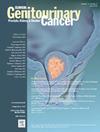侵袭性尿路上皮癌新辅助和诱导化疗的有效和无效生存率:临床和病理分期匹配分析。
IF 2.7
3区 医学
Q3 ONCOLOGY
引用次数: 0
摘要
简介/背景:最近的一项研究报道,在RC之前接受新辅助/诱导化疗(NAIC)的残余膀胱尿路上皮癌患者,与病理分期匹配的患者相比,表现出较差的肿瘤预后。我们的假设是,这可能归因于术前ct分期的变化,而不是化疗的影响。患者和方法:这项回顾性多中心研究纳入了2010年至2017年期间因cT2-4N0-3M0疾病接受RC治疗的513例患者。根据病理结果对患者进行分类:病理完全缓解(pCR, (y)pT0N0),完全降期(pCD, (y)pT0/is/a/1N0)和残余肌肉侵袭性和/或淋巴结阳性疾病(rmbc, (y)pT2-4N0和/或(y)pN1-3)。结果:在整个队列中,175例(34.1%)患者接受了NAIC+RC, 338例(65.9%)患者接受了前期RC。NAIC+RC患者表现出较低的年龄和cci评分,以及较高的ct&n分期(p值均< 0.001)。nac +RC组生存期为60.5个月,前期RC组生存期为49.4个月(p值= 0.171)。在rMIBC患者中,NAIC+RC后的生存率低于术前RC。然而,NAIC+RC和前期RC之间的临床分期分布不平衡,cT2N0患者分别为3%和49%,cT4b和/或N+患者分别为47%和9%。在多变量Cox比例风险分析中调整cT和n期、年龄和cci评分后,较差的OS与前期RC相关(HR 1.52, [95% CI, 1.11-2.10], p值= 0.009)。结论:cT2-4N0-3M0 rMIBC患者在NAIC+RC后的生存率低于术前RC的患者,这是由于术前特征(包括临床分期)更差。在生存分析中,临床疾病分期的表征不应被忽视。本文章由计算机程序翻译,如有差异,请以英文原文为准。
Survival in Responders and Nonresponders of Neoadjuvant and Induction Chemotherapy in Invasive Urothelial Carcinoma of the Urinary Bladder: A Clinical and Pathological Stage-Matched Analysis
Introduction/Background
A recent study reported that patients with residual urothelial carcinoma of the bladder subsequent to neoadjuvant/induction chemotherapy (NAIC) prior to RC exhibited inferior oncological outcomes in comparison to pathological stage-matched patients who underwent upfront RC. Our hypothesis is that this may be ascribed to variations in preoperative CT-stage rather than the impact of chemotherapy.
Patients and Methods
This retrospective multicentre study included 513 patients who underwent RC for cT2-4N0-3M0 disease between 2010 and 2017. Patients were categorized based on pathological outcomes: pathological complete response (pCR, (y)pT0N0), complete downstaging (pCD, (y)pT0/is/a/1N0) and residual muscle-invasive and/or node positive disease (rMIBC, (y)pT2-4N0 and/or (y)pN1-3).
Results
Of the total cohort, 175 (34.1%) patients underwent NAIC+RC, while 338 (65.9%) underwent upfront RC. NAIC+RC patients exhibited lower age and CCI-scores, along with higher cT&N-stage (all P-values < .001). The mOS was 60.5 months for NAIC+RC and 49.4 months for upfront RC (P-value = .171). In patients with rMIBC, survival was inferior after NAIC+RC compared to upfront RC. However, the clinical stage distribution between NAIC+RC and upfront RC was imbalanced, with 3% versus 49% cT2N0 patients and 47% versus 9% cT4b and/or N+ patients, respectively. Following adjustments for cT & N-stage, age, and CCI-scores in multivariable Cox proportional-hazards analysis, worse OS was associated with upfront RC (HR 1.52, [95% CI, 1.11-2.10], P-value = .009).
Conclusion
The observed inferior survival in cT2-4N0-3M0 patients with rMIBC after NAIC+RC compared to those undergoing upfront RC resulted from worse preoperative characteristics, including clinical stage. The representation of clinical disease stage should not be overlooked in survival analyses.
求助全文
通过发布文献求助,成功后即可免费获取论文全文。
去求助
来源期刊

Clinical genitourinary cancer
医学-泌尿学与肾脏学
CiteScore
5.20
自引率
6.20%
发文量
201
审稿时长
54 days
期刊介绍:
Clinical Genitourinary Cancer is a peer-reviewed journal that publishes original articles describing various aspects of clinical and translational research in genitourinary cancers. Clinical Genitourinary Cancer is devoted to articles on detection, diagnosis, prevention, and treatment of genitourinary cancers. The main emphasis is on recent scientific developments in all areas related to genitourinary malignancies. Specific areas of interest include clinical research and mechanistic approaches; drug sensitivity and resistance; gene and antisense therapy; pathology, markers, and prognostic indicators; chemoprevention strategies; multimodality therapy; and integration of various approaches.
 求助内容:
求助内容: 应助结果提醒方式:
应助结果提醒方式:


